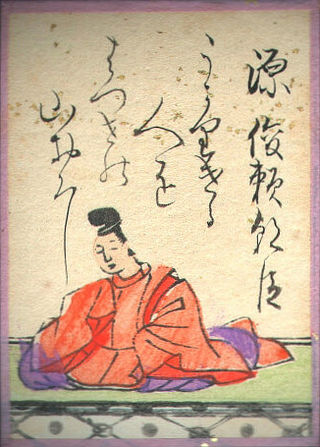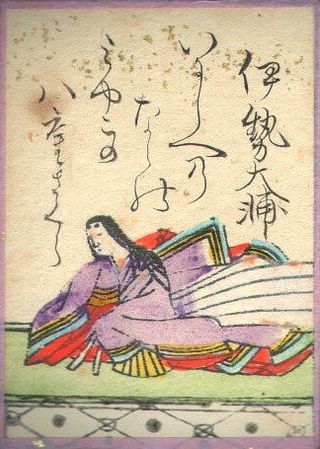This article presents lists of the literary events and publications in the 11th century.

Minamoto no Shunrai also Minamoto Toshiyori was an important and innovative Japanese poet, who compiled the Gosen Wakashū. He was the son of Minamoto no Tsunenobu (1016–1097); holder of the second rank in court and of the position of Grand Counsellor). Shunrai was favored by Emperor Go-Sanjo and to a lesser degree Emperor Shirakawa; in no small part for political reasons. At this time, the Fujiwara family dominated the country, and its branch, the Rokujō family, similarly dominated the court poetry scene; by favoring their rivals, the Emperors could thus strike back. Although Shunrai was passed over to compile the Goshūi Wakashū. Shunrai's angry polemical Nan Goshūi appears to have somehow convinced Shirakawa to have Shunrai compile the next imperial anthology, the Kin'yō Wakashū. This anthology, when completed, embroiled Shunrai in dispute, and his Gosen Wakashū was especially criticized with various uncomplimentary nicknames; Brower and Miner mention that one critic, Fujiwara no Akinaka wrote a now-lost ten-part work called the Ryōgyokushū which did nothing but mock and criticize the Kin'yō Wakashū.
This page is part of the List of years in poetry. The List of years in poetry and List of years in literature provide snapshots of developments in poetry and literature worldwide in a given year, decade or century, and allow easy access to a wide range of Wikipedia articles about movements, writers, works and developments in any timeframe. Please help to build these lists by adding and updating entries as you use them. You can access pages for individual years within the century through the navigational template at the bottom of this page, and you can access pages for other centuries through the navigational template to the right. To access the poetry pages by way of a single chart, please see the Centuries in poetry page or the List of years in poetry page.
Years link to corresponding "[year] in poetry" articles.

Fujiwara no Kintō, also known as Shijō-dainagon, was a Japanese poet, admired by his contemporaries and a court bureaucrat of the Heian period. His father was the regent Fujiwara no Yoritada and his son Fujiwara no Sadayori. An exemplary calligrapher and poet, he is mentioned in works by Murasaki Shikibu, Sei Shōnagon and in a number of other major chronicles and texts.

Akazome Emon was a Japanese waka poet and early historian who lived in the mid-Heian period. She is a member both of the Thirty Six Elder Poetic Sages and the Thirty Six Female Poetic Sages.

Izumi Shikibu was a mid-Heian period Japanese poet. She is a member of the Thirty-six Medieval Poetry Immortals. She was the contemporary of Murasaki Shikibu, and Akazome Emon at the court of empress Joto Mon'in.

Ise no Taifu (伊勢大輔), also known as Ise no Tayū or Ise no Ōsuke, was a Japanese poet active in the early 11th century.

The Thirty-Six Immortals of Poetry are a group of Japanese poets of the Asuka, Nara, and Heian periods selected by Fujiwara no Kintō as exemplars of Japanese poetic ability. The oldest surviving collection of the 36 poets' works is Nishi Honganji Sanju-rokunin Kashu of 1113. Similar groups of Japanese poets include the Kamakura period Nyōbō Sanjūrokkasen (女房三十六歌仙), composed by court ladies exclusively, and the Chūko Sanjūrokkasen (中古三十六歌仙), or Thirty-Six Heian-era Immortals of Poetry, selected by Fujiwara no Norikane (1107–1165). This list superseded an older group called the Six Immortals of Poetry.
Nationality words link to articles with information on the nation's poetry or literature.
Nationality words link to articles with information on the nation's poetry or literature.
Heian literature or Chūko literature refers to Japanese literature of the Heian period, running from 794 to 1185. This article summarizes its history and development.

Daini no Sanmi was a Japanese waka poet of the mid-Heian period.

Uma no Naishi was a Japanese Waka poet and noble from the middle Heian period. She is enumerated as one of the Thirty-Six Female Immortals of Poetry alongside famous authors, poets, and contemporaries Sei Shōnagon and Murasaki Shikibu.

The Thirty-Six Immortal Women Poets, is a canon of Japanese poets who were anthologized in the middle Kamakura Period. The compiler and exact date of the canon's construction is unknown, but it's reference is subsequently noted in the Gunsho Ruijū, volume 13.








